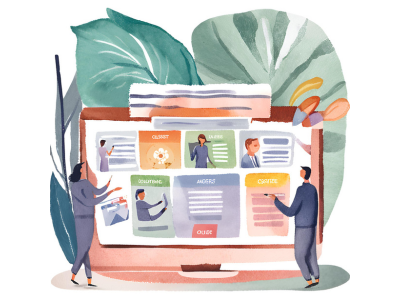What Elements does a Successful Landing Page Need?

First things first, what is actually a landing page? A landing page is an essential part of any successful online business. It is the first point of contact, usually the home page, where potential customers can access your product or service and see what you are all about. Once potential clients “land” on your page, they are more likely to engage with your product or service: You just have to make sure that you offer them the best landing experience possible.
Therefore, creating a successful landing page requires a thoughtful combination of creativity, data-driven strategies, and effective conversion practices. Here’s a straightforward checklist to guide you in crafting the ideal landing page:
1. Hero Section:
- Company Logo: Ensure your branding is visible right away.
- Headline: Develop a compelling headline that grabs attention and clearly communicates your value proposition.
- Subheading: Offer a brief explanation or supporting statement that enhances the headline.
- Image or Video: Use visual elements to illustrate your product or service effectively.
- Call-to-Action (CTA): Position a clear and prominent CTA button that directs users toward the next step.
2. Social Proof (Customer Logos):
- Showcase logos of reputable customers to foster credibility and trust.
3. Benefits Section:
- Key Benefits: List the main benefits of your product or service clearly, using bullet points or icons for easy understanding.
- Features: Highlight significant features of your product, ensuring they relate directly to the benefits.
- Supporting Images/Graphics: Incorporate visuals that reinforce the benefits and demonstrate your product in action.
- Repeat CTA: Include your CTA button in each section for easy access.
4. Social Proof (Testimonials):
- Customer Testimonials: Feature quotes from satisfied clients, ideally with names and photos, to enhance authenticity.
5. FAQ Section:
- Common Questions: Address frequently asked questions to mitigate any hesitations.
- Clear Answers: Provide concise, informative responses that empower readers to make informed decisions.
6. Final CTA:
- Strong Call-to-Action: Reinforce your CTA. Make it compelling and clear.
7. Footer Section:
- Contact Information: Include essential contact details such as email, phone number, and physical address.
- Legal Pages: Offer links to important documents like your Privacy Policy and Terms of Service.
Quick Tips:
- Make your CTA button the most eye-catching color on your page to draw attention.
- Keep your copy short and clear; prioritize scannability.
- Ensure your website is mobile-friendly by optimizing the design for mobile users and keeping images at manageable file sizes.
- Conduct A/B tests regularly to determine which copy and images yield the highest conversions.
By checking off each of these elements, you’re not just designing a page; you’re creating an experience that transforms visitors into loyal customers. And if you need more guidance, click the button below and let’s get started.